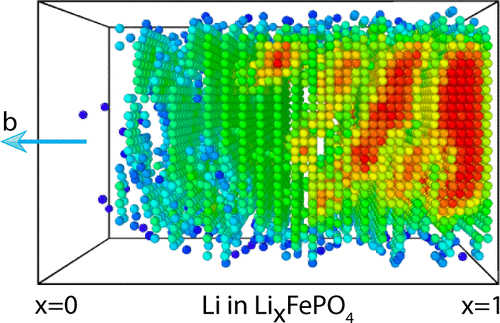Our official English website, www.x-mol.net, welcomes your
feedback! (Note: you will need to create a separate account there.)
Kinetic Monte Carlo Study of Li Intercalation in LiFePO4
ACS Nano ( IF 15.8 ) Pub Date : 2018-01-02 00:00:00 , DOI: 10.1021/acsnano.7b08278 Penghao Xiao 1 , Graeme Henkelman 1
ACS Nano ( IF 15.8 ) Pub Date : 2018-01-02 00:00:00 , DOI: 10.1021/acsnano.7b08278 Penghao Xiao 1 , Graeme Henkelman 1
Affiliation

|
Even as a commercial cathode material, LiFePO4 remains of tremendous research interest for understanding Li intercalation dynamics. The partially lithiated material spontaneously separates into Li-poor and Li-rich phases at equilibrium. Phase segregation is a surprising property of LiFePO4 given its high measured rate capability. Previous theoretical studies, aiming to describe Li intercalation in LiFePO4, include both atomic-scale density functional theory (DFT) calculations of static Li distributions and entire-particle-scale phase field models, based upon empirical parameters, studying the dynamics of the phase separation. Little effort has been made to bridge the gap between these two scales. In this work, DFT calculations are used to fit a cluster expansion for the basis of kinetic Monte Carlo calculations, which enables long time scale simulations with accurate atomic interactions. This atomistic model shows how the phases evolve in LixFePO4 without parameters from experiments. Our simulations reveal that an ordered Li0.5FePO4 phase with alternating Li-rich and Li-poor planes along the ac direction forms between the LiFePO4 and FePO4 phases, which is consistent with recent X-ray diffraction experiments showing peaks associated with an intermediate-Li phase. The calculations also help to explain a recent puzzling experiment showing that LiFePO4 particles with high aspect ratios that are narrower along the [100] direction, perpendicular to the [010] Li diffusion channels, actually have better rate capabilities. Our calculations show that lateral surfaces parallel to the Li diffusion channels, as well as other preexisting sites that bind Li weakly, are important for phase nucleation and rapid cycling performance.
中文翻译:

LiFePO 4中锂嵌入的动力学蒙特卡洛研究
即使作为商业阴极材料,LiFePO 4对于理解Li嵌入动力学仍然具有巨大的研究兴趣。部分锂化的材料在平衡时自发地分为贫锂相和富锂相。鉴于其高的测速能力,相分离是LiFePO 4的令人惊讶的特性。先前的理论研究,旨在描述LiFePO 4中的Li嵌入包括基于静态参数的原子尺度密度泛函理论(DFT)计算和基于经验参数的全粒子尺度相场模型,研究了相分离的动力学。很少有人努力弥合这两个尺度之间的差距。在这项工作中,基于动力学蒙特卡洛计算,使用DFT计算来拟合簇的扩展,从而可以进行长时间的具有精确原子相互作用的模拟。此原子模型显示了在没有实验参数的情况下Li x FePO 4中的相如何演化。我们的模拟显示,在LiFePO之间形成有序的Li 0.5 FePO4相,沿ac方向交替出现富锂和贫锂的平面4相和FePO 4相,这与最近的X射线衍射实验一致,后者显示了与中间Li相相关的峰。该计算还有助于解释最近的令人费解的实验,该实验表明,高纵横比的LiFePO 4颗粒实际上在垂直于[010] Li扩散通道的方向上沿[100]方向较窄。我们的计算表明,平行于Li扩散通道的侧面以及弱结合Li的其他先前存在的位点对于相成核和快速循环性能很重要。
更新日期:2018-01-02
中文翻译:

LiFePO 4中锂嵌入的动力学蒙特卡洛研究
即使作为商业阴极材料,LiFePO 4对于理解Li嵌入动力学仍然具有巨大的研究兴趣。部分锂化的材料在平衡时自发地分为贫锂相和富锂相。鉴于其高的测速能力,相分离是LiFePO 4的令人惊讶的特性。先前的理论研究,旨在描述LiFePO 4中的Li嵌入包括基于静态参数的原子尺度密度泛函理论(DFT)计算和基于经验参数的全粒子尺度相场模型,研究了相分离的动力学。很少有人努力弥合这两个尺度之间的差距。在这项工作中,基于动力学蒙特卡洛计算,使用DFT计算来拟合簇的扩展,从而可以进行长时间的具有精确原子相互作用的模拟。此原子模型显示了在没有实验参数的情况下Li x FePO 4中的相如何演化。我们的模拟显示,在LiFePO之间形成有序的Li 0.5 FePO4相,沿ac方向交替出现富锂和贫锂的平面4相和FePO 4相,这与最近的X射线衍射实验一致,后者显示了与中间Li相相关的峰。该计算还有助于解释最近的令人费解的实验,该实验表明,高纵横比的LiFePO 4颗粒实际上在垂直于[010] Li扩散通道的方向上沿[100]方向较窄。我们的计算表明,平行于Li扩散通道的侧面以及弱结合Li的其他先前存在的位点对于相成核和快速循环性能很重要。











































 京公网安备 11010802027423号
京公网安备 11010802027423号